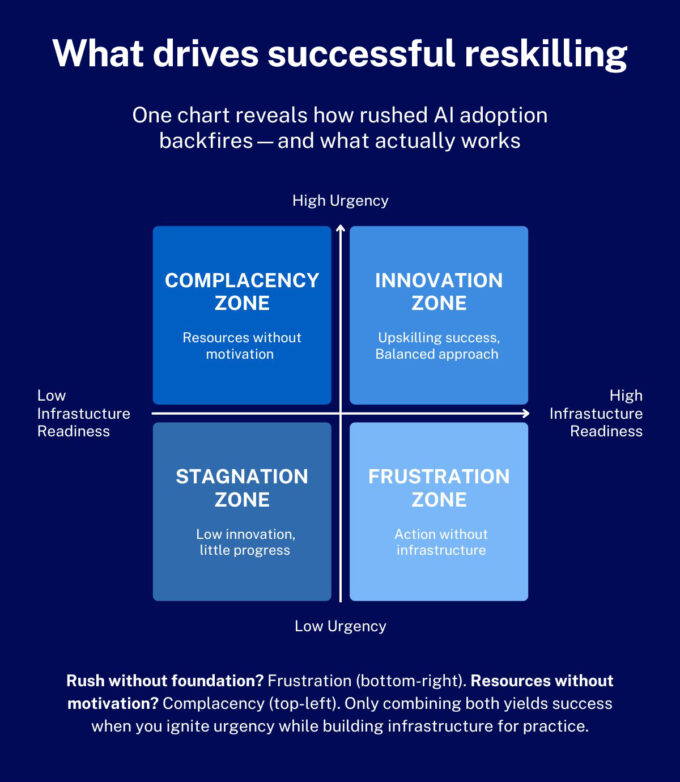
Can you rely on AI? Use our checklist to avoid the pitfalls
In a world of deepfakes, hallucinations, and bias, we offer practical guidance on how you can trust your AI systems....
Audio available

by Howard H. Yu Published 20 May 2025 in Artificial Intelligence • 7 min read
AI is redefining the scope of business performance. No longer an experimental add-on, AI is capable of rapidly implementing operational efficiencies and enhancements such as hyper-personalization. CEOs know this. What remains unclear is how to harness the full potential of AI.
Here lies the paradox of AI implementation in a training context. Many organizations invest in digital learning platforms – but employees still struggle to apply new skills on the job. This isn’t a training failure; it’s a structural one. Just as the steam engine took decades to reshape factory productivity, AI’s transformative potential requires more than technical readiness – it demands workforce readiness.
The future belongs to organizations that ignite a sense of urgency around AI – while building the practical infrastructure to support experimentation and application.
In today’s AI-powered environment, technical ability alone won’t deliver transformation. The new advantage lies in problem framing, judgment, and the ability to work symbiotically with machines – skills that emerge not through passive instruction, but through embedded, real-world experience.
Companies that fall behind in terms of skills will fall behind in terms of performance. They also risk irrelevance if their workforce isn’t adapting to AI-enhanced work. To unlock that value, companies must rethink how people learn, practice, and adapt. Those that reskill successfully will capture the speed and scale advantages that companies like Nvidia now enjoy.
Without clear pathways to apply what they’ve learned in real situations, the training ‘rush’ fades fast.
Companies are pouring resources into upskilling and reskilling, but many still struggle to turn training into tangible change. Employees often emerge from training sessions energized – brimming with ideas and eager to put new skills to work. But back at their desks, that momentum fizzles out. Without clear pathways to apply what they’ve learned in real situations, the training ‘rush’ fades fast. The result? A frustrating gap between potential and progress.
Reskilling isn’t about ticking off e-learning modules or collecting certifications. It’s about enabling people to drive change, whether by identifying opportunities to use AI or experimenting with solutions in their day-to-day roles. The jobs of the future will reward not rote execution, but critical thinking and iterative problem-solving in partnership with machines. The real transformation comes not from competing with AI, but from learning to thrive alongside it.
Why do so many companies fall short? Because the barriers are cultural and structural. Hierarchies remain rigid. Siloed departments stifle experimentation. Leadership hesitates to decentralize decision-making. And in the absence of psychological safety, few employees will take the initiative to experiment with AI, regardless of training.
The chart below illustrates a simple truth: reskilling only succeeds when infrastructure and motivation align. Pouring resources into training without empowering people to act leads to frustration. Cultivating urgency without support leads to chaos. True transformation comes when employees are both equipped and energized to apply what they’ve learned.

In the context of AI-driven transformation, modular design offers “innovation without the chaos.” Take the case of Mastercard, which shows how modular systems can drive digital innovation in the global payments industry. At its heart,”modularity” means breaking down complex, monolithic systems into modules, which enables faster modification and more efficient scaling.
Few areas of financial services have seen as much technological disruption as payments. The rise of digital and mobile tools has triggered the most fundamental transformation since the introduction of plastic cards half a century ago. Once dominated by a few banking behemoths, payments can now be made using a range of devices and across multiple channels.
Rather than relying on its reputation and affluent customer base, Mastercard responded by repositioning itself as a technology partner with a central commitment to modularity. This approach reshaped both Mastercard’s internal systems and the way it engaged with partners.
That openness extended to the FinTech subsector. Mastercard has worked hard to position itself as a preferred collaborator for new entrants by sharing tools, offering access, and encouraging co-creation. Developers could plug into its network via application programming interfaces (APIs), underlining the strengths of a platform-based model. This model feeds a cycle of innovation that delivers new services to consumers and businesses alike.
By diligently measuring AI’s real-world impact on cycle times, output quality, or customer satisfaction, leaders can ensure they stay ahead of the game.
All companies can access frontier tech. But not all can turn it into productivity. Seminal analysis by the OECD found a growing gap between top-performing firms and the rest even when access to frontier technologies is broadly the same.
The difference? Leading firms don’t just adopt tech – they absorb it. They have “complementary capabilities”: advanced skills and workforce training, strong management and leadership, modern organizational practices, and access to finance, scale, and networks. These aren’t nice-to-haves; they’re what make the tech work.
Laggard firms often miss those pieces. They may have the same access to technology, but without the capacity to reshape workflows or upskill teams, the benefits stall. Same tech, different outcomes.
Another trap is the absence of robust metrics. By diligently measuring AI’s real-world impact on cycle times, output quality, or customer satisfaction, leaders can ensure they stay ahead of the game. This means benchmarking AI-enabled workflows against traditional processes. Are customer service agents responding faster? Are supply chain forecasts more accurate? Is AI-enhanced personalization driving higher conversion rates?
At global learning company Pearson, CFO Sally Johnson isn’t just talking about AI experiments, she’s also seeing real results. GenAI tools built into the company’s higher education courseware are driving performance where it counts. “For products using those AI study tools, we’ve seen double-digit revenue growth,” says Johnson. “So, it’s making a difference from a commercial point of view, as well.”

To scale from isolated pilots to transformation, CEOs must provide an organizational environment that welcomes AI:
Programs must go beyond passive learning. Employees should work on real projects that integrate AI tools, whether experimenting with predictive analytics or GenAI in content creation. The emphasis must be on “learning by doing” and business relevance.
Provide safe environments in which teams can test AI use cases without performance pressure. These sandboxes encourage experimentation and foster a culture of curiosity. Crucially, businesses must shield these sandboxes from bureaucratic drag to avoid smothering innovation.
A case in point is Coca-Cola’s approach to GenAI. As Pratik Thakar, their Head of Generative AI, explains: “Gen AI is already distributed, it’s democratized. Everyone has access to it, and people can come up with ideas. We have created an internal mechanism where everyone who wants to use gen AI fills out a very simple form and our small team looks at it and maybe we say, ‘That’s a perfect use of AI – maybe just not that particular tool.'”
Track how AI affects both internal efficiencies and customer-facing outcomes. Measuring impact helps maintain focus, justify investments, and reinforce a results-oriented mindset.
In a world racing to harness intelligent machines, the differentiator won’t be access to technology; rather, it will be human adaptability.
Effective reskilling creates a virtuous cycle; the “flywheel effect.” Learning feeds application, which leads to the results that motivate endeavor and accelerate investment.
Organizations that fail to act decisively will soon find themselves at a disadvantage in terms of talent retention, while struggling to maintain market relevance. As AI evolves, so does the competition.
In a world racing to harness intelligent machines, the differentiator won’t be access to technology; rather, it will be human adaptability. CEOs who reskill their people and empower them to act will set a pace that others will struggle to match.

LEGO® Chair Professor of Management and Innovation at IMD
Howard Yu, hailing from Hong Kong, holds the title of LEGO® Professor of Management and Innovation at IMD. He leads the Center for Future Readiness, founded in 2020 with support from the LEGO Brand Group, to guide companies through strategic transformation. Recognized globally for his expertise, he was honored in 2023 with the Thinkers50 Strategy Award, recognizing his substantial contributions to management strategy and future readiness. At IMD, Howard directs the Strategy for Future Readiness program.

15 May 2025 • by Öykü Işık, José Parra Moyano in Artificial Intelligence
In a world of deepfakes, hallucinations, and bias, we offer practical guidance on how you can trust your AI systems....
 Audio available
Audio available
14 May 2025 in Artificial Intelligence
Companies are rushing to embrace the game-changing opportunities to improve operations and scale that AI offers; yet many are unaware of the pitfalls. Test your knowledge of the risks here – and...

12 May 2025 in Artificial Intelligence
In an era defined by advanced AI and behavioral data, Apple’s 'Evil Steve' test exemplifies a proactive approach to ethical decision-making and responsible data governance....

8 May 2025 • by Tomoko Yokoi, Michael R. Wade in Artificial Intelligence
The race to harness artificial intelligence is reshaping the financial services landscape, with industry leaders demonstrating how strategic AI implementation drives competitive advantage. IMD's AI Maturity Index reveals the winning formula. ...
Explore first person business intelligence from top minds curated for a global executive audience